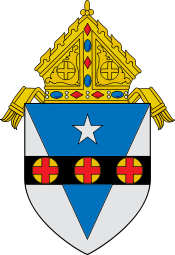Old St. Joseph's Church
| Old St. Joseph's Church | |
|---|---|
 | |
| 39°56′47″N 75°08′51″W / 39.946445°N 75.147597°WCoordinates: 39°56′47″N 75°08′51″W / 39.946445°N 75.147597°W | |
| Location | 321 Willings Alley, Philadelphia, Pennsylvania, 19106 |
| Country | United States |
| Denomination | Catholic Church |
| Website |
oldstjoseph |
| History | |
| Founded | 1733 |
| Founder(s) | Fr. Joseph Greaton SJ |
| Dedicated | February 9, 1839 |
| Architecture | |
| Architect(s) | John Darragh |
| Administration | |
| Diocese | Archdiocese of Philadelphia |
| Province | Philadelphia |
| Clergy | |
| Vicar(s) | Fr. Edward O’Donnell, S.J. |
| Pastor(s) | Fr. Philip Florio, S.J. |
Old St. Joseph's Church was the first Roman Catholic church in Philadelphia, Pennsylvania, U.S. founded in 1733.
History
Old St. Joseph's Church was founded by Fr. Joseph Greaton, an English Jesuit who came to Philadelphia from Maryland in 1729 to establish a mission.[1] He originally celebrated Mass in his house at 321 Willings Alley. Father Greaton built the first chapel in 1733, almost certainly a house-chapel attached to the residence of Father Greaton.
The right of Catholics to worship in Pennsylvania at what was termed the "Romish Chapel" was challenged the following year[2] by the Governor General of Pennsylvania.[3] The Pennsylvania Provincial Assembly ultimately decided not to ban celebration of Mass and cited William Penn's Charter of Privileges as controlling, despite the English Penal Laws. No where else could Catholics enjoy public worship to the extent possible in 18th century Philadelphia.[1]
In 1757, the chapel was replaced by a larger church.[2] Marquis de Lafayette and the Comte de Rochambeau, worshiped at St. Joseph.[4] The American and French armies celebrated high mass at St. Joseph's after the victory at Yorktown.[5]
In 1793 a yellow fever epidemic swept the central area of Philadelphia, killing ten per cent of the population. Old St. Joseph's established an orphanage to care for some of the many children left without families due to the epidemic. The church became racially integrated in the 1790s when slaves fleeing a revolution in Santo Domingo settled in Philadelphia and some joined the church. St. Mary's Charity School educated these immigrants, ultimately leading to the establishment of St. Peter Claver School in Philadelphia later in the 19th Century.[6]
Nearby St. Mary's Church, built in 1763, was used for grander occasions—and was visited by public dignitaries such as George Washington and John Adams.
Parish
The church remains an active parish of the Archdiocese of Philadelphia, run by the Jesuit fathers, with Masses Monday through Saturday at 12:05 p.m. and Sabbath Masses at 5:30 p.m. Saturday and, on Sundays, at 7:30, 9:30, and 11:30 a.m. and 6:30 p.m.[7] The current pastor is Fr. Philip Florio, S.J. Under the church's "Carewalk" program workers take food to the area's homeless in the evenings.[8]
Architecture
The church structure is uniquely sited and nearly impossible to see from the street. One story relates that Benjamin Franklin advised Father Greaton to protect the church, since religious bigotry wasn't unknown even in the Quaker city.[9] The front wall of the church is a party wall to a neighboring structure and so provides no means of entrance. The entrance to the church from Willings Alley remains through a narrow arch with iron gates which opens to an unassuming courtyard which conceals the nature of the church building.[4] On one occasion Quakers had to patrol St. Joseph's to prevent a Protestant mob from disrupting the service.[10] The only entrances to the sanctuary are on either side, towards the back of the church, because there are unrelated buildings in front of and behind the church building on Walnut and Fourth Streets.
The present church is the third on the site and was dedicated in 1839. Parishioner John Darragh was the builder-architect. In 1886, major renovations were undertaken to the church by architect John J. Deery. Other renovations by architects Walter Francis Ballinger and Emil George Perrot took place in 1904 .[11]
Filippo Costaggini's 1886, "The Angelic Exaltation of St. Joseph into Heaven, is a circular painting 15 feet in diameter fixed to the ceiling. It depicts St. Joseph surrounded by angels with an infant Jesus on his lap bearing lilies, the flower associated with the saint. Done in the Italian Neoclassical style that dominated Catholic churches in the late 19th century, it is recognized as historically significant by the Philadelphia Historical Commission.[12]
The large painting of the Crucifixion above the altar, was done about 1840 by parishioner Sylvano Martinez.[12]
Legacy
Eight Catholic dioceses trace their root to Jesuit missionaries from Old St. Joseph's.[8]
St. Joseph's University and St. Joseph's Preparatory School were founded at Old St. Joseph's in 1841[13] and 1851[14] respectively.
See also
References
- 1 2 "History", Old St. Joseph's church
- 1 2 "Old St. Joseph’s Catholic Church", VisitPhilly
- ↑ Griffin, Martin Ignatius Joseph. History of "old St. Joseph's," Philadelphia, I.C.B.U. Journal Print, 1882
- 1 2 "Old St. Joseph's Church & National Shrine", USHistory.org
- ↑ "The Yorktown Celebration", Donahoe's Magazine, vol.6, T.B. Noonan, 1882
- ↑ "Old St. Joseph's", PhilaPlace, Historical Society of Pennsylvania
- ↑ "Old St. Joseph's", Archdiocese of Philadelphia
- 1 2 "Old St. Joseph’s Church", The Jesuits
- ↑ "Old St. Joseph's Church", Frommers
- ↑ "Old St. Joseph's Church", Fodor's
- ↑ "Old St. Joseph's Church", Historic Campus Architecture Project, Council of Independent Colleges
- 1 2 Crimmins, Peter. "Painting in Philly's Old St. Joseph's Church gets historical panel blessing", Newsworks, WHYY
- ↑ "History of SJU", St. Joseph's University
- ↑ http://www.sjprep.org/page.cfm?p=506
